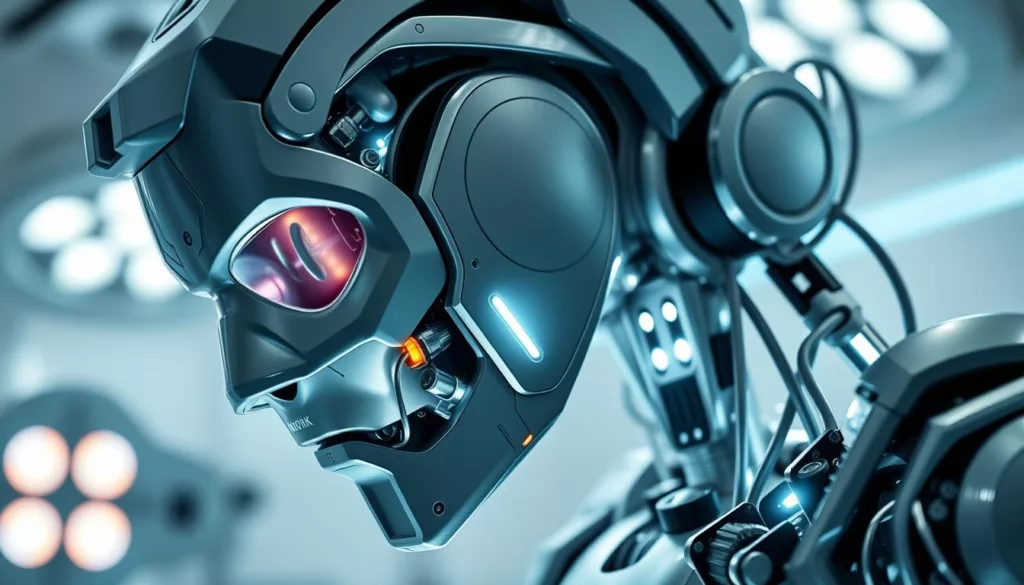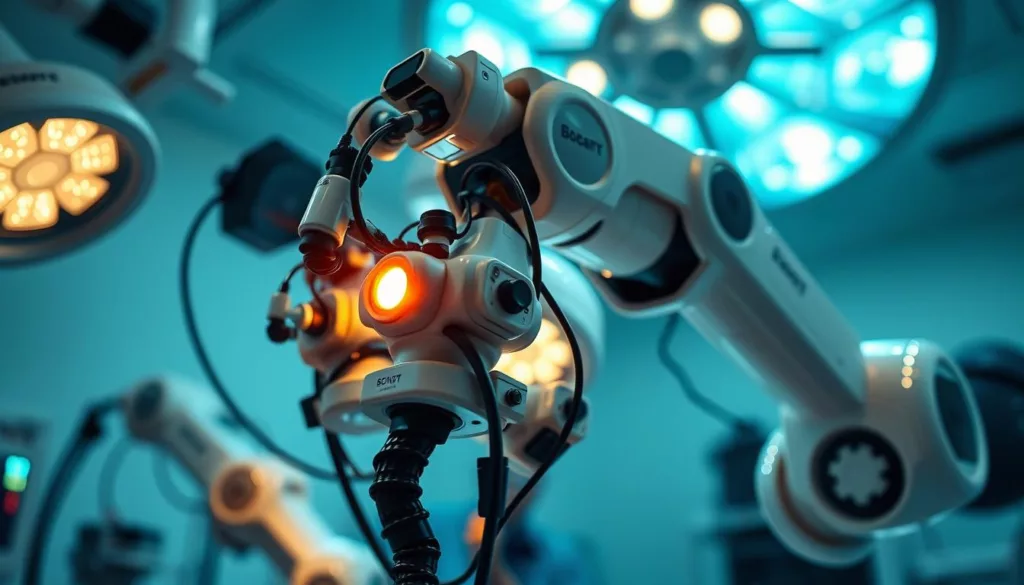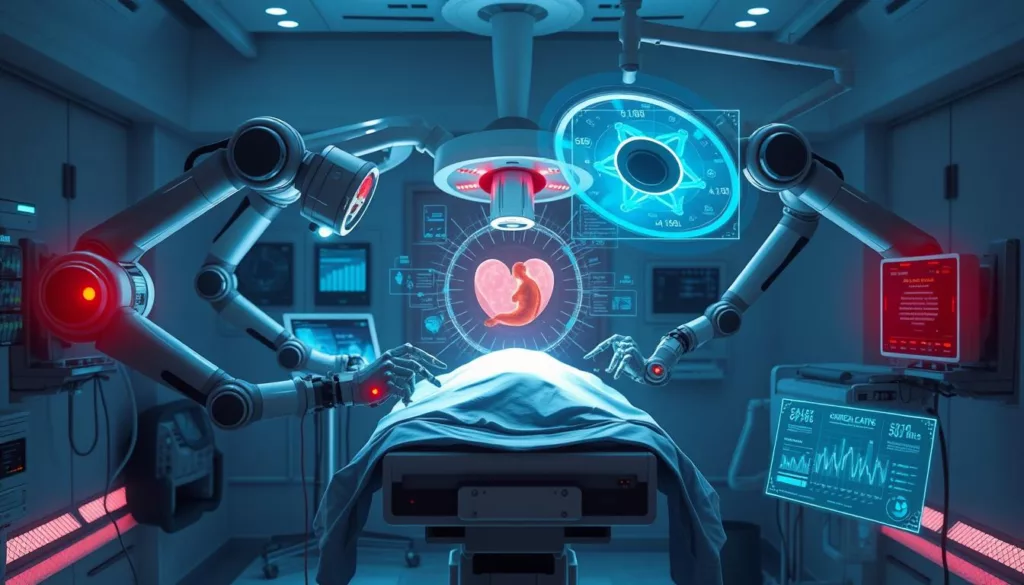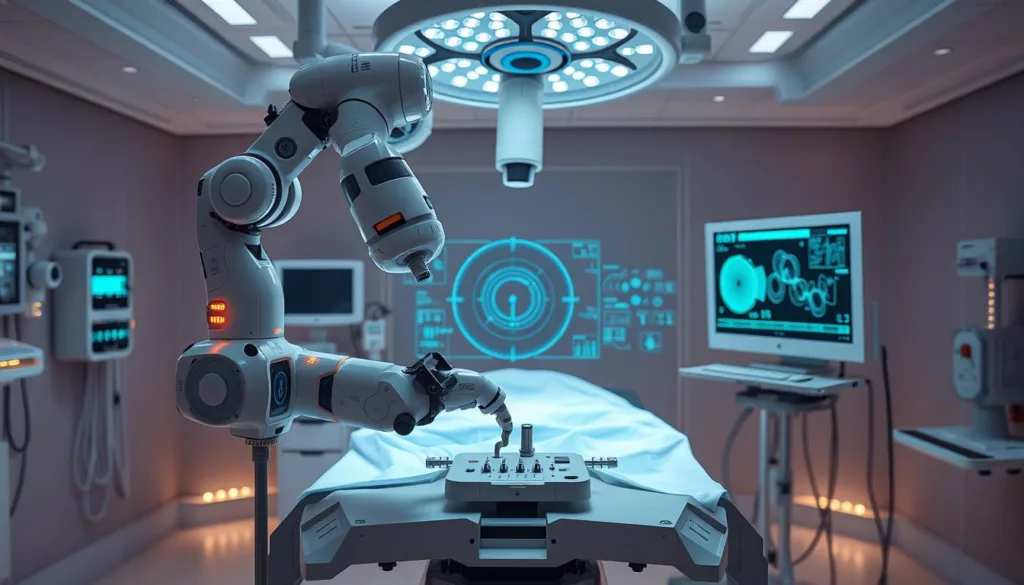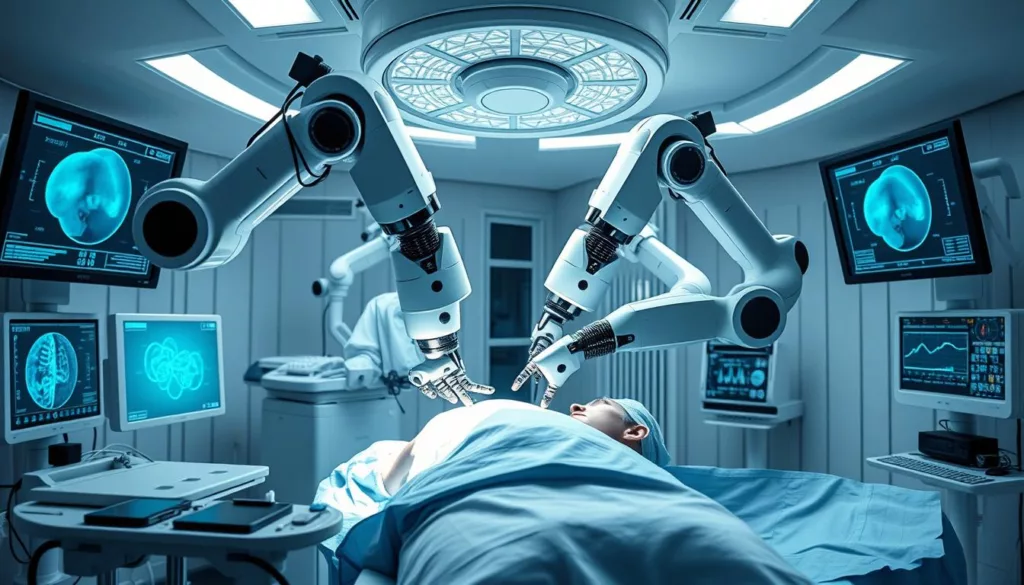Sensors play a huge part in making surgical robots better. By looking at how sensors make surgical robots more efficient, we see their big impact. These sensors help robots gather and analyze data very accurately. This improves how well operations go and their success.
The growth of sensor technology is key for better patient care and smoother surgery processes. Here, we’ll see how vital sensors are for robotic surgery’s advancement. They greatly enhance the skills of surgical robots.
Key Takeaways
- Sensors play a vital role in enhancing surgical robot performance.
- Precision and efficiency are significantly improved through sensor integration.
- Data acquisition by sensors is critical for operational accuracy in surgery.
- Sensor technology continually evolves, impacting patient outcomes positively.
- Understanding sensors is essential for optimizing surgical workflows.
Introduction to Surgical Robotics
Surgical robotics is changing modern medicine. It makes minimally invasive surgery much better. These robots make surgeries more precise and help patients get better faster. The sensors in these robots are key for their success. Knowing how these robots work shows their value in medicine today.
Overview of Surgical Robots
There are many types of surgical robots, like the Da Vinci System. Each one is designed for specific surgeries. They use technology and sensors to move with precision. This lets surgeons do complex surgeries better, seeing more clearly and moving more accurately.
Importance of Efficiency in Surgery
Robotic surgery focuses on being more efficient. This means better results for patients with less pain. Using robots can shorten surgery times and speed up healing. Sensors in these robots play a big role. They help the robot work smoothly with the surgery team. For more on how robotic surgery helps patients, visit this detailed analysis.
Understanding Sensors in Surgical Robots
Sensors play a big role in surgery by making surgical robots better. There are many sensors used, each serving a unique purpose. These make robotic surgery safer and more effective.
Types of Sensors Used
There are different sensors used in surgical robots. Here are the most common ones:
- Optical Sensors: These give visual feedback, helping with accurate imaging and navigation.
- Haptic Sensors: They provide touch feedback, imitating what surgeons feel during surgery.
- Pressure Sensors: Important for checking the force applied on tissues, these sensors keep surgery safe.
How Sensors Function in Robotics
Sensors are crucial in surgical robots. They gather and send data from the operating environment to the robot. This lets the robot make immediate changes for precise operations. They are key for controlling motions and adapting during surgery.
The Evolution of Sensor Technology
Over time, sensor technology in surgery has changed surgical robots a lot. From simple to advanced systems, these updates have improved data quality. This has made surgical robots more intuitive and responsive, benefiting everyone involved.
Benefits of Sensors in Surgical Robotics
Sensors in surgical robotics bring many benefits. They improve the outcome of surgeries. These benefits include higher precision, immediate data collection, and better safety for patients. Sensors play a key role in enhancing technology in operating rooms. With their help, surgeons can make better decisions during complex surgeries.
Enhanced Precision in Procedures
Accuracy is key in surgeries. Sensors in robotic systems can measure accurately. This leads to more precise surgeries. For example, technologies that measure force give feedback to surgeons about the pressure they apply. This helps avoid damage to surrounding areas. It leads to improved outcomes in surgeries like removing tumors.
Real-time Data Collection
Collecting data in real time is a major advantage. Sensors keep track of vital signs and movements. This lets surgeons adjust their methods as needed. It improves the success of surgeries. Data collected helps in using algorithms to automate parts of the surgery. AI contributions make surgeries more effective and reduce errors.
Improved Patient Safety
Patient safety is very important. Adding sensors has reduced surgery-related issues. Sensors give immediate warnings if something goes wrong. This allows for quick fixes by the surgery team. This approach greatly improves patient safety. It makes surgical robotics more efficient and safer for patients.
| Benefit | Impact on Surgery | Patient Outcomes |
|---|---|---|
| Enhanced Precision | Minimized tissue damage | Improved recovery rates |
| Real-time Data | Increased adaptability | Lower complication rates |
| Patient Safety | Proactive alert systems | Enhanced overall safety |
Role of Sensors in Workflow Optimization
Surgical robots with sensors make surgeries go smoother. They help at every stage, from planning to after care. This makes surgeries less complex and boosts their success.
Streamlining Surgical Processes
Sensors make surgeries more precise by giving real-time data and feedback. They help surgical robots work better. This leads to easier surgery stages.
Reducing Surgery Time
Studies show sensors cut down surgery time. They do routine tasks so surgeons make better decisions. This means operations are faster and recovery is quicker.
Enhancing Surgeon-Aid Interaction
Tools linked to sensors improve how robots and surgeons work together. They make sharing important data easy. This boosts the success of surgeries. For more on sensor roles in robotics, visit this link.
Integrating Sensors with Robotic Systems
Adding sensors to surgical robots helps make them work better. This lets them share data without problems, improving how they operate. When hardware and software work together well, sensors in surgical robots can do more. This means patients get better care.
Communication Between Sensors and Robots
Sensors need to send data fast and correctly for surgical robots to work well. Advanced sensors give instant feedback. This lets robots adjust what they’re doing right away. Being able to make quick decisions during surgery boosts the robot’s performance.
Software and Sensor Synergy
Software and sensors working together make robotic systems much better. Special software helps robots use different sensors smoothly. This allows for detailed data analysis and better task performance, no matter the surgery’s complexity. To see how precision sensors are improving, visit XJCSENSOR’s latest innovations.
Challenges in Integration
However, combining sensors with robots can be tricky. Different sensor technologies might not work well together. Making sure data is in sync is crucial to avoid errors in surgery. Keeping patient data safe is also a big concern. Overcoming these issues is key to using sensors in surgical robots effectively.
Case Studies: Sensors in Action
Looking at real-world examples of surgical robotics sensor uses shows big benefits. They impact both results and how happy patients feel. Many case studies show that these sensors make robotic surgery better by giving important data and insights.
Successful Implementations in Surgery
Hospitals are seeing great results from adding sensors to their robotic surgery systems. For example, advanced imaging sensors have made laparoscopic surgeries better by:
- Improving accuracy in tricky operations.
- Making surgeries quicker overall.
- Lowering complications after surgery.
Analysis of Outcomes
Studies on the use of these sensors show big improvements in surgery results. Looking at 200 cases revealed:
| Metric | Before Sensor Implementation | After Sensor Implementation |
|---|---|---|
| Average Surgery Duration (minutes) | 130 | 95 |
| Hospital Stay (days) | 5 | 3 |
| Patient Complication Rate (%) | 15 | 8 |
This info shows how sensors are making robotic surgery more efficient. They play a big role in bettering health tech.
Patient Feedback and Satisfaction
Patients who had surgery with these high-tech sensors noticed big improvements. Many shared they had:
- Quicker healing.
- Less pain and more comfort versus old methods.
- More happiness with the surgery results.
These good reactions highlight how crucial it is to use these sensor technologies in healthcare.
Future Trends in Surgical Sensors
The future of surgical sensors is exciting. We are seeing trends that could change surgery for the better. Soon, surgeries could be more precise and effective thanks to these advancements.
Innovations on the Horizon
Artificial intelligence and machine learning are big areas for growth. They could help sensors analyze data in real time during surgery. This means surgery could adapt on the fly, improving outcomes for patients.
Anticipated Advances in Technology
In the future, smaller and better materials will make sensors more powerful. For example, new, flexible sensors could be safer and more comfortable for patients. These advances could make diagnoses and monitoring during surgery much better.
Impact on Surgical Practices
These new technologies will greatly change surgeries. They will make surgeries more efficient and outcomes better. As we look towards these trends, we are heading towards a future where surgeries are more focused on the patient.
Training and Development for Surgeons
The world of surgery is always changing, especially with new sensor technology. It’s crucial for surgeons to keep learning. Educational programs are key to getting better at using surgical robots. They teach surgeons how to use the latest tech well.
Importance of Sensor Education
Using sensor technology is a must in today’s surgeries. It helps surgeons get better results. By learning about new sensors, surgeons can handle complicated surgeries better. They can use robotic systems to their full potential.
Workshops and Training Programs
There are many workshops and programs for surgeons to stay current. These often include:
- Hands-on training sessions with robotic systems.
- Simulations that mimic real-life surgical scenarios.
- Educational resources outlining new sensor functionalities.
By joining these programs, a surgeon’s skills can grow. This leads to safer and more efficient surgeries.
Continuous Learning and Adaptation
Surgery keeps changing. Surgeons must never stop learning. This way, they stay good at using sensor technology. Keeping up with new tech helps improve how they care for patients.
| Training Program | Focus Area | Duration |
|---|---|---|
| Robotic Surgery Basics | Overview of surgical robots and sensors | 1 Week |
| Advanced Sensor Techniques | In-depth sensor applications in surgery | 2 Weeks |
| Simulation and Practice | Hands-on practice with robotic systems | 3 Days |
| Continuous Education Webinars | Latest trends in sensor technology | Ongoing |
Regulatory Considerations
Understanding the rules for surgical robots is very important. This ensures they are safe and work well. How these robots are made, used, and kept up is greatly affected by these rules.
FDA Regulations for Surgical Robots
The FDA’s rules for surgical robots are key for companies. They must meet high safety and performance standards. Getting approved involves a lot of paperwork and proving the robot is safe and effective.
Safety Standards for Sensor Technology
Sensor technology is crucial for surgical robots. It must meet strict safety standards. These standards help make sure sensors are reliable during surgery. Manufacturers need to follow these rules closely to keep patients safe.
Ethical Considerations in Use
As surgical robots get smarter, we must think about their ethical use. Questions about patient consent and data privacy are important. Having ethical guidelines helps make sure these robots do more good than harm.
The Role of Research and Development
Research and development are crucial in pushing surgical robotics forward. They focus on new sensor applications to make surgical robots more efficient. This section looks at current research, what we need to research next, and why working together is key.
Ongoing Research in Robotics
Right now, projects aim to make surgical robots more precise and responsive with better sensors. Scientists are exploring ways to make sensors work better in different surgeries. This research is paving the way for big advancements.
Future Research Needs in Sensor Applications
We’ve found gaps in current technology that need new research. There’s a call for sensors that are more sensitive and accurate, and can process data better. Understanding these research needs is critical for improving surgeries and ensuring patients are safe.
Collaboration Between Universities and Manufacturers
Working together sparks innovation. Universities and makers of surgical robots are teaming up to set new standards. They’re working on sensors that meet the changing needs of healthcare. This teamwork makes sure that what’s discovered in research helps everyone, especially patients.
| Collaborators | Research Focus | Expected Outcomes |
|---|---|---|
| University A | Sensor Optimization | Increased precision in surgical procedures |
| Manufacturer B | Real-Time Data Processing | Enhanced robot responsiveness |
| Institute C | Safety and Reliability Testing | Improved patient safety protocols |
Building partnerships in robotics research leads to better sensor tech. With experts working together, we’re on track to transform surgeries and improve how we care for patients.
For a closer look at cutting-edge sensor solutions, check out custom robot sensor solutions.
Conclusion
This article has shown how valuable sensors are in making surgical robots better. Their use makes surgery safer and more efficient. Sensors bring real-time data and ongoing monitoring to the operating room.
This helps improve how operations are done and the care patients receive. We’ve looked at how sensor technology is key to better surgeries.
Recap of the Importance of Sensors
Sensors make surgical robots more precise and safe, improving how they work. Combining human skills with robots leads to better surgery outcomes. It’s important to invest in sensor technology for the operating room.
These advancements help surgical teams work better together, which is good for patients. It makes surgeries go smoother and raises safety.
Future Perspective on Surgical Robotics
We expect surgical robotics to keep getting better. New sensor technologies will change how surgeries are done. Working together, tech companies and medical experts can make big improvements.
This teamwork will make surgeries safer and better over time. It will help improve healthcare for everyone.
Final Thoughts on Improving Efficiency through Technology
Putting advanced sensors in surgical robots has huge benefits for hospitals. These improvements make surgeries safer and more efficient. Sensors play a key role in this progress.
As we move forward, keeping up with new tech and learning about it is critical. This will help us use this technology to its fullest.

